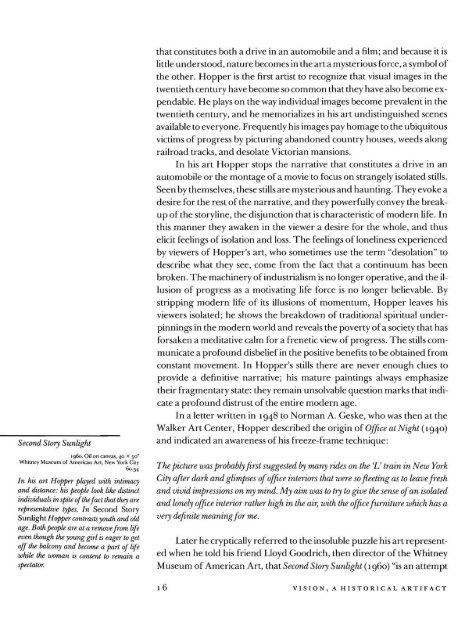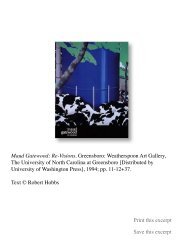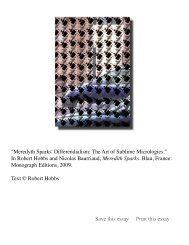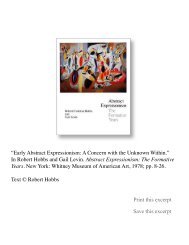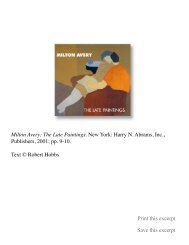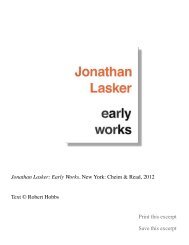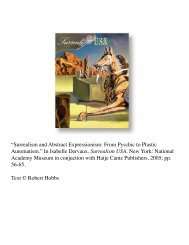Edward Hopper - Robert Hobbs
Edward Hopper - Robert Hobbs
Edward Hopper - Robert Hobbs
You also want an ePaper? Increase the reach of your titles
YUMPU automatically turns print PDFs into web optimized ePapers that Google loves.
Second Story Sunlight19fio. Oil on canvas, 40 X 50"Whitney Museum of American An, New York City00-54In his art <strong>Hopper</strong> pla)'f!d with intimacyand distance: his people look like distinctindivid1.Ul.l.s in spite of the fact that they arerepresentative types. In Second StorySunlight <strong>Hopper</strong> contrasts youth and oldage. Both people are at a remove from lifeeven though the young girl is eager to getoff the balcony and become a part of lifewhile the woman is content to remain aspectator.that constitutes both a drive in an automobile and a film; and because it islittle understood, nature becomes in the art a mysterious force, a symbol ofthe other. <strong>Hopper</strong> is the first artist to recognize that visual images in thetwentieth century have become so common that they have also become expendable.He plays on the way individual images become prevalent in thetwentieth century, and he memorializes in his art undistinguished scenesavailable to everyone. Frequently his images pay homage to the ubiquitousvictims of progress by picturing abandoned country houses, weeds alongrailroad tracks, and desolate Victorian mansions.In his art <strong>Hopper</strong> stops the narrative that constitutes a drive in anautomobile or the montage of a movie to focus on strangely isolated stills.Seen by themselves, these stills are mysterious and haunting. They evoke adesire for the rest of the narrative, and they powerfully convey the breakupof the storyline, the disjunction that is characteristic of modern life. Inthis manner they awaken in the viewer a desire for the whole, and thuselicit feelings of isolation and loss. The feelings of loneliness experiencedby viewers of <strong>Hopper</strong>'s art, who sometimes use the term "desolation" todescribe what they see, come from the fact that a continuum has beenbroken. The machinery of industrialism is no longer operative, and the illusionof progress as a motivating life force is no longer believable. Bystripping modern life of its illusions of momentum, <strong>Hopper</strong> leaves hisviewers isolated; he shows the breakdown of traditional spiritual underpinningsin the modern world and reveals the poverty of a society that hasforsaken a meditative calm for a frenetic view of progress. The stills communicatea profound disbelief in the positive benefits to be obtained fromconstant movement. In <strong>Hopper</strong>'s stills there are never enough clues toprovide a definitive narrative; his mature paintings always emphasizetheir fragmentary state: they remain unsolvable question marks that indicatea profound distrust of the entire modern age.In a letter written in 1948 to Norman A. Geske, who was then at theWalker Art Center, <strong>Hopper</strong> described the origin of Office at Night ( 1940)and indicated an awareness of his freeze-frame technique:The picture was probably first suggested fry many rides on the 'L' train in New YorkCity after dark and glimpses of office interiors that were so fleeting as to leave freshand vivid impressions on my mind. My aim was to try to give the sense of an isolatedand lonely office interior rather high in the air, with the office furniture which has avery definite meaning for me.Later he cryptically referred to the insoluble puzzle his art representedwhen he told his friend Lloyd Goodrich, then director of the WhitneyMuseum of American Art, that Second Story Sunlight ( 1960) "is an attempt16 VISION, A HISTORICAL ARTIFACT


